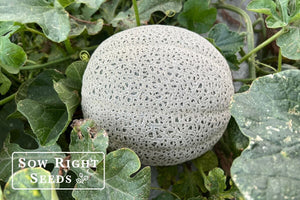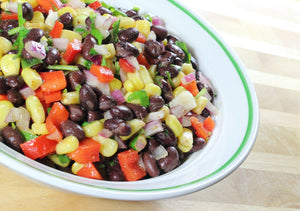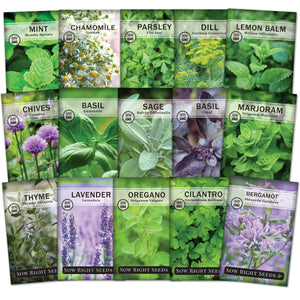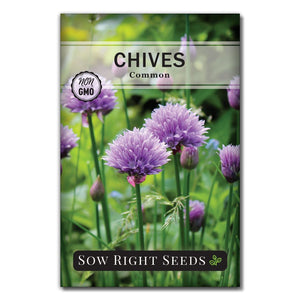How to Grow Chives - Why Your Garden Loves This Oniony Herb
Herb growing tipsFrom a quick glance in the grocery store or farmers market, you might mistake chives for green onions. When you see them chopped up or their green leaves poking through the soil, they look almost identical. But when you dig beneath the surface and look closely at these two cousins, you’ll see and taste why chives deserve their own spot in your kitchen.

What Are Chives?
If you’ve ever wanted to grow your own herbs, chives are the one to start with. Chives are a perennial and the only member of the onion family to be considered an herb. They are also one of the easiest herbs to grow. Chives can grow in many locations, including indoors. They are a beneficial companion plant to many vegetables, and their edible flowers attract pollinators, which makes them welcome in all kinds of gardens. How can you go wrong growing an herb with this kind of easygoing lifestyle?
Garlic chives vs common chives
There are two main types of chives, garlic chives, and common chives - usually just referred to as chives. Garlic chives are sometimes referred to as Chinese chives. The appearance and taste of the two varieties are different and they are not used interchangeably in recipes.
Common chives have a round hollow leaf, and garlic chives have a flat, grasslike appearance. And as the name suggests, they taste like garlic, although much more mild.
Chives are often used raw as a garnish, and garlic chives can be a main ingredient and are usually cooked. They are often used in stir-fries and other dishes where their texture and taste hold up to the heat.
Their flowers are another quick identifier of what type of chives you are growing. Chives have purple flowers, and garlic chives have white flowers.
Garlic chives grow taller but less dense than common chives and are less cold-hardy.
Chives vs Green Onions - What’s the difference?


While the difference between chives and green onions may seem subtle, once you know how to grow and use chives, you’ll understand why they’re not the same and why you’ll always want to have chives in your garden.
Both chives and green onions are in the allium family, along with garlic and leeks. They are both bright green and have an onion flavor. However, chives are much milder than onions.
Both chives and green onions have hollow tubular leaves that are chopped and enjoyed raw. Chives have narrower leaves and a slightly drier texture. Chives also lose their flavor when cooked.
You can substitute green onions for chives, but you will get a slightly different taste and texture. Also, because of the milder flavor of chives, you will have to use more to achieve the same impact.
Green onions are also called scallions, and you’ll often see them referred to as such in recipes. Consider planting bunching onions if you want to grow your own green onions.
How to Grow Chives
Planting Chives From Seed
Chive seeds can be started indoors 6 to 8 weeks before the last frost date.
Chive seeds can also be sown directly in the garden as soon as the ground warms up. For the best germination results, the soil temperature should be between 65-70 degrees F.
To plant chives, spread the seeds on the soil and cover to a planting depth of 1/4”.
Keep the seeds moist, and they will germinate in 7 to 15 days.
Chive plants should be spaced 6” apart to allow room for growth.
Common chives will grow 10 to 15 inches tall, and garlic chives can grow to 2 feet tall.
Chives will grow best in a rich loamy soil. But they are adaptable and will grow in all kinds of soil. Adding organic compost will give you a rich soil for growing chives.
Keep the soil watered without completely drying out. While they can tolerate some drought conditions and not completely die off, they won’t put out new growth or flower.
Full sun is best for growth, but chives can also tolerate shade. That’s what makes them so easy to grow just about anywhere. However, they will bloom more in full sun.
Chives are considered cool-weather plants and will go dormant in hot summer weather. They will also go dormant in the winter but regrow when it warms up in the spring.
Chives grow in clumps, and every third year you can divide them. This is a great time to add them to new locations in your garden and put them in pots to grow indoors.
Unlike other herbs that quit growing when they flower, chives will continue to grow. So don’t worry if you see flowers. You can still enjoy your chives. However, cutting off flowers will encourage new growth.

Chives as a Companion Plant
If you want a natural way to reduce pests in your garden, plant chives! Chives can repel aphids, Japanese beetles, and cabbage worms. So plant chives next to broccoli, cabbage, strawberries, kohlrabi, parsley, carrots, and beets.

Growing Chives Indoors
Chives are also easy to grow indoors, where they can adapt to artificial light and lower light levels in a sunny window. For optimal growth, they will still need 6 hours of sunlight.
Chives are perfect for a kitchen culinary garden. Even during the winter, with enough light, you can have fresh chives ready to add to all kinds of dishes, and you’ll feel like a master chef.
To grow chives indoors, you can start plants from seed or divide them from clumps growing in your outdoor garden. Divided chives will continue growing, and it’s a great way to bring them inside through the winter.
Before bringing them inside, cut them off 1 inch above the ground. Then divide the clumps as needed and put them into a pot. Within a few weeks, you will have new growth.

How to Harvest Chives
When your chive plant is above 6 inches tall, it’s ready to start harvesting. Cut off stalks of chives 1 to 2 inches from the ground. (I find flower scissors to be the best for cutting chives. You can also use flower scissors or sharp kitchen shears to cut them up when using them in recipes.) Cutting at the base of the chive plant encourages more growth. After cutting, chives will typically grow back within a few weeks. You can cut off just a few leaves at a time or whole bunches.
In the winter, you can cut the whole chive plant down to 1 inch, and it will grow back in spring.
Chives will self-seed if the blooms are allowed to fully mature and go to seed. So, if you want to control their growth and keep chives from spreading in your garden, you’ll need to pick the flowers.

Are Chive Flowers Edible?
Chive flowers are beautiful and deliciously edible. They can be used as a garnish and to make flavorful vinegar. The stems with flowers are a little woodier and tougher, but they are also edible.
The flowers are their most tender and tasty when the blossoms have just opened. As they continue flowering, chive flowers will develop seeds and won’t be as tender. You can eat the whole flower, but often the petals are scattered over a dish as a colorful garnish.
Chive flowers can also be used as cut flowers in bouquets. Garlic chives have white flowers and usually bloom in late summer to early fall. Common chives have purple flowers and bloom in May and June.

Tips for Growing Garlic Chives
Garlic chives grow much like common chives, with a few differences.
The seeds of garlic chives can take longer to germinate than common chives. They also grow more slowly and don’t need to be divided as often.
One growing technique for garlic chives is to cover them with straw as they grow to keep them out of the sunlight. This keeps the leaves from turning green, giving them a white or “blanched” appearance. This blanching also results in a more mild flavor.
How to Store Chives
To keep chives fresh longer, don’t wash them until you are ready to use them. Wrap chives in a paper towel and place them in a plastic bag. They will last 10 to 14 days in the refrigerator before they start to wilt or turn brown.
Chives can also be frozen. Chop them up and then lay them flat to freeze. They won’t look nice as a garnish, but they can be added to cooked recipes. Another freezing method is to put them in ice cube trays and add water. Once the cubes are frozen, place them in a bag and store them in the freezer for 4-6 months.
Drying chives will allow them to last for about 2 years. They will lose their color and have a different texture, but they can be added to dips and sauces.
To dry chives, cut them up as you would for a recipe and then dry them in a food dehydrator. Another drying method is to tie them in bundles to air dry and then cut them up after they are dry.
Once chives are dry, they can be stored in an airtight jar away from sunlight.
Chive Recipes
Chive butter - Mix 1/2 cup butter with 2 to 6 tablespoons of chives, depending on the strength of flavor you want. Let the butter sit for at least 30 minutes before using it to give time for the flavors to meld. Wrap it in plastic wrap to form it into a log and cut slices off to use on fish, toast, potatoes, and other foods. Chive butter can last in the fridge for several days.
Chive Sour Cream - Chives are a classic with sour cream on a baked potato. They can also be added to mashed potatoes and twice-baked potatoes, and, well, just about any potato dish. Fresh or dried chives can be added to sour cream and allowed to sit for the flavor to develop. Then add additional chives for a colorful garnish.
Chive blossom vinegar - Put 1 cup of chive flowers into 1 cup of white wine vinegar. Let it sit at room temperature for 1-2 weeks. (This isn’t an exact recipe. Feel free to add more or less blossoms to adjust the flavor. Also, the longer the blossoms sit in the vinegar, the stronger the flavor.) Once you have the flavor you want, strain out the blossoms and store the vinegar in a glass jar. You can use both common chives and garlic chives. The purple chive blossoms will create a beautifully colored vinegar.
As you see, chives are not the same as green onions or scallions. Whether common or garlic, chives deserve their own special spot in the kitchen herb garden. And since they are so easy to grow, why not try chives this year?










Leave a comment